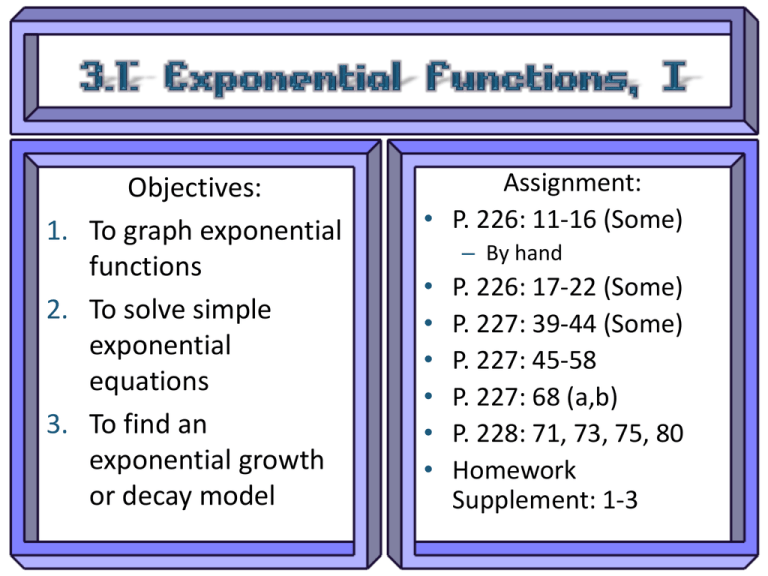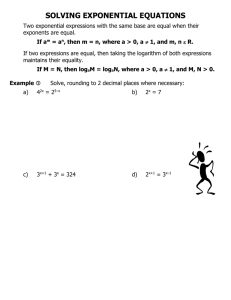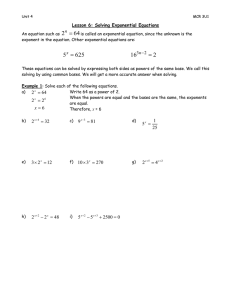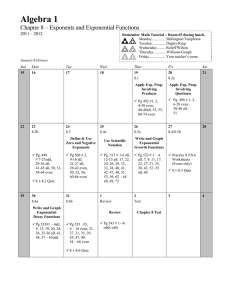
Objectives:
1. To graph exponential
functions
2. To solve simple
exponential
equations
3. To find an
exponential growth
or decay model
Assignment:
• P. 226: 11-16 (Some)
– By hand
•
•
•
•
•
•
P. 226: 17-22 (Some)
P. 227: 39-44 (Some)
P. 227: 45-58
P. 227: 68 (a,b)
P. 228: 71, 73, 75, 80
Homework
Supplement: 1-3
The fictional Gordon Moore
Intelligence Reward
Organization (GMIRO) has
decided to reward one
clever and assiduous
student by giving them a
substantial amount of
money. This student must
make one of 2 choices:
Gordon Moore: Richer than you.
1. GMIRO gives the student a
penny on the first day. On
the second day, GMIRO will
double the penny. On the
third day, GMIRO will double
the money from the
previous day. GIMRO will
continue to do this until the
end of the month when they
will give you the final sum of
money.
Gordon Moore: Richer than you.
2. GMIRO gives the student
one million dollars.
As a potential candidate for
GMIRO’s reward, which
option would you choose?
Gordon Moore: Richer than you.
The number of
transistors on an
integrated circuit
(IC) doubles every 2
years.
• N2 = 2(y2 – y1)/2·N1
©Pearson Prentice Hall, 2004
Consider the algebraic expression 3(2x + y). We
usually think of this as 3 distributed through
the parenthesis, but it also means 3 copies of
2x + y:
2x + y
+
2x + y
+
2x + y
Multiplication is simply repeated addition.
Now consider the algebraic expression (2x + y)3.
What could be done to the illustration below
to represent this new expression?
(2x + y)
x
(2x + y)
x
(2x + y)
An exponent is simply repeated multiplication.
Simplify the following expressions:
5
m
3
m
Here’s a few good properties:
Multiplication
Property of
Exponents
Power
Properties of
Exponents
bm·bn = bm+n
b
=
nm
b
m
(ab)n = anbn b
(bm)n
bmn
Division
Property of
Exponents
n
Simplify the following expressions:
32
74
4
74
3
And here’s a couple more:
Negative Exponents
b
n
1
n
b
1
n
b
n
b
Zero Exponents
b0 = 1
(b ≠ 0)
Square, cube, nth
roots can be
written using
rational
exponents. In
other words,
roots have
fractional
exponents.
a
a
x
2
2
a
Let a x a
a
So a1 2 a
a2x a
a 2 x a1
2x 1
1
x
2
Square, cube, nth
roots can be
written using
rational
exponents. In
other words,
roots have
fractional
exponents.
c
n
c
x
n
n
c
Let c x n c
c
So c1 n n c
c nx c
c nx c1
nx 1
1
x
n
Without a calculator, evaluate the following.
You
will be
able to graph
exponential functions
An exponential function with base b is denoted
as f (x) = bx, where b > 0 and b ≠ 1.
If b = 1, then we’d have y = 1x.
It’s constant.
Which is just y = 1.
And that’s not exponential.
Without a calculator,
graph each of the
following:
1. f (x) = 2x
2. g (x) = 3x
3. h (x) = 4x
Graph of y = bx, b > 1
Domain: (−∞, ∞)
Range: (0, ∞)
Horizontal asymptote: y = 0
y-intercept: 1
Increasing (growth)
Continuous
One-to-one
Without a calculator,
graph each of the
following:
1. f (x) = 2−x
2. g (x) = 3−x
3. h (x) = 4−x
Graph of y = b-x, b > 1
Domain: (−∞, ∞)
Range: (0, ∞)
Horizontal asymptote: y = 0
y-intercept: 1
Decreasing (decay)
Continuous
One-to-one
How you learned it
last year:
y 2 x
1
y x
2
1
y
2
x
Also notice that the
graph of y = b−x is
the same as y = bx,
just reflected over
the y-axis.
Use the following GSP
demo to discover the
roll of a, h, and k in
the exponential
function:
y a b
xh
k
Identify the parent for each function, then state
the SRT transformations to make each graph.
Finally, state the domain and range of each.
1. y = 4x – 2
2. y = −(1/2)‧3x
3. y = 2−x + 3
You will be able to solve simple exponential equations
Horizontal Line Test
One-to-One
Every input has 1 output
Every output has 1 input
Enables us to solve simple
exponential equations
when the bases are equal.
If 2x = 23, then what is the value of x?
Property of Equality of Exponential Equations
If b is a positive real number not equal to 1,
then bx = by iff x = y.
– 2x = 23 iff x = 3
– This means that one way to solve exponential
equations is to make the bases equal so that the
exponents are equal.
Solve:
You
will be
able to find
an exponential
growth or decay model
Often in a problem, you have to add a
percentage of a price back to the price, like
taxes and tips. To do this, add one to the
percent, and then multiply.
x 8%x
x .08x
x 1 .08
x 1.08
$5.50 8% $5.50
$5.50 .08 $5.50
$5.50 1 .08
$5.50 1.08
In many real-life situations, a quantity will grow
at a constant rate. This is like the previous
tip/tax problem, except it is done over and
over again.
$5.50 1.081.08 1.08 1.08 1.08 1.08 1.08 1.08 1.08
$5.50 1.08
t
In a real-life situation, when a quantity a
continues to increased by a fixed percent r
each year (or some other time frame), the
amount y of the quantity after time t can be
modeled by:
y a 1 r
t
Growth Factor
According to some website, the population of
Denton, TX was 119,454 in 2008. This was up
from 3.01% from the previous year. If the
population continues to grow at this rate,
what do you expect the population of Denton
to be in 2020?
Often in a problem, you have to subtract a
percentage of a price from the price, like
discounts. To do this, subtract the percent
from one, and then multiply.
x 10%x
x .1x
x 1 .1
x .9
$5.50 10% $5.50
$5.50 .1 $5.50
$5.50 1 .1
$5.50 .9
In many real-life situations, a quantity will shrink
at a constant rate. This is like the previous
discount problem, except it is done over and
over again.
$5.50 .9 .9 .9 .9 .9 .9 .9 .9 .9 .9 .9 .9 .9 .
$5.50 .9
t
In a real-life situation, when a quantity a
continues to decrease by a fixed percent r
each year (or some other time frame), the
amount y of the quantity after time t can be
modeled by:
y a 1 r
t
Decay Factor
A new car costs $25,000. The value of the car
decreases by 15% each year. Write an
exponential decay model giving the car’s value
y (in dollars) after t years. Estimate the value
after 2 years.
Assume the car from the previous example
continues to decrease in value by 15% every
year. In how many years with the value of the
car be ½ the original value?
The MSRP on my 2001 Honda Civic LX was
$14,810. Currently, the Kelley Blue Book Price
for the same car averages $4,913. Write an
exponential decay model for the value V of my
car t years after 2001. Then find the year
when my car will be worth a measly $1,000.
Objectives:
1. To graph exponential
functions
2. To solve simple
exponential
equations
3. To find an
exponential growth
or decay model
Assignment:
• P. 226: 11-16 (Some)
– By hand
•
•
•
•
•
•
P. 226: 17-22 (Some)
P. 227: 39-44 (Some)
P. 227: 45-58
P. 227: 68 (a,b)
P. 228: 71, 73, 75, 80
Homework
Supplement: 1-3







